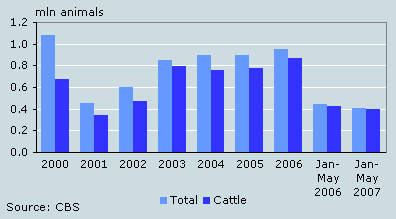Downturn in sheep trade

Dutch imports and exports of sheep and goats declined markedly in 2006 relative to the preceding year. This was partly due to the outbreak of bluetongue disease (catarrhal fever). Cattle imports rose by 12 percent, while cattle exports declined by 19 percent.
Exports of ruminants

Reduction in exports of sheep and goats
Two thirds of Dutch exports of ruminants consist of sheep and goats. In 2006, the Netherlands exported over half a million of sheep and goats, nearly one quarter down on 2005. Cattle exports fell by one fifth to nearly 240 thousand.
In the first five months of 2007, exports of sheep and goats were also below average. In the period January-May 2007, more than 180 thousand animals were exported. This is more than one third below the level of the previous year.
Exports of ruminants by destination

France largest buyer
For nearly 40 percent of sheep, goats and cattle exported by the Netherlands, France was the country of destination in 2006. Although exports to France dropped by more than one third relative to 2005, this country remains the most important buyer.
Exports to Spain, another important buyer of Dutch sheep and goats, also dropped considerably in 2005. One quarter of total Dutch exports of sheep and goats went to Spain in 2005.
Imports of ruminants

Mainly cattle imported
Last year, imports of ruminants rose marginally by 6 percent. Altogether, 954 thousand animals were imported. The majority were cattle. Cattle imports grew by 12 percent relative to 2005. Imports of sheep and goats, on the other hand, decreased by 28 percent.
Wiel Packbier